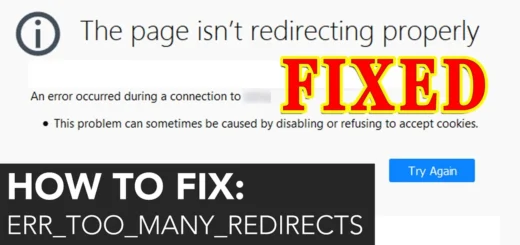How To Fix OpenAI Error Code 401? 5 Easy Troubleshooting Ways!
If you are a netizen who loves internet surfing then you might be familiar with different error codes that pop-up out of nowhere when you try to load a website. Today we are going to find solutions for fixing one such OpenAI error code which is 401. Stay and learn how to fix OpenAI error code 401 with us, if this is something of your interest.
OpenAI error 401 or 401 unauthorized errors has become one of the most common errors taking place while trying to load any webpage. OpenAI error 401 indicates that the request sent to the web application the webpage could not be supported. But luckily, we have a solution for OpenAI error code 401. It doesn’t take much of a time to resolve the issue if you know how to fix OpenAI error code 401.
You can clear browser cache and cookies, cross check if the URL link is correct or not or can delete DNS cache for how to fix OpenAI error code 401. To know how you can do all these in detail read the article till the end.
In this detailed guide, you will learn everything about OpenAI error 401 like its causes and consequences along with how to fix OpenAI error code 401. So, be prepared to troubleshoot this error whenever you face this one next time with the help of this step wise guide.
How To Fix OpenAI Error Code 401?
The OpenAI 401 error occurs when the server’s request was not accepted\ authenticated or verified because of the lack of authentication credentials provided by you for the target resource. Whenever you try to access a link or a website, a request from your browser’s end is sent to which sometimes cannot get verified and ends up showing you OpenAI error 401.
This error code is also indicated by HTTP 401 Unauthorized Error and mainly occurs at the customers end. There are multiple variations of the same error code like you will get to see 401 unauthorized error, error 401 unauthorized, access denied, 401 unauthorization required etc.
What Causes OpenAI Error 401?
The following reasons can be the cause of OpenAI error 401:
- Plugin incompatibility
- Incorrect link
- Wrong login trials with incorrect credentials
- Outdated browser cookies and cache
- IP limitations
- Server configuration errors
For example, the OpenAI error 401 pop-ups when you try to access any limited or exclusive passcode-protected website without signing up in the beginning or providing the authentic required information.
So, in order to prevent it from spoiling your surfing experience, let us help you a bit by exploring ways to fix OpenAI error 401 in the next section.
How To Fix OpenAI Error 401?
Whenever you receive any notification ending or beginning with error 401, just assume that you need to perform the given set of instructions one by one to troubleshoot the glitch. Mainly, this glitch occurs because of the problems taking place at the consumer’s end and other than that it occurs because of glitches at the web server, like restricting the consumer from using the desired web page or breaking the authentication process.
NOTE: Make sure you recheck the website and look if it isn’t down from the server itself and if everyone is facing the or if it’s only you who is getting interrupted with OpenAI error 401. By this you will get to know if the issue is server-based or local.
Here are some troubleshooting methods for fixing OpenAI error 401. Do not forget to try each one out!
Fix 1: Cross Check Authenticity Of URL
You will now think what a solution it is, isn’t it obvious to follow the correct link, but the OpenAI error 401 appears mostly when the user fills an incorrect URL in the search bar of the browser. So, it’s crucial to make sure that you are attempting to access the correct URL by looking for any special characters or numbers on which you might have missed. In case of hyperlinks from different websites or applications you can look for typos like mistyping or outdated links.
Fix 2: Clear Cookies And Browser Cache
There are a number of issues that can take place at the user’s end resulting in showing OpenAI error 401. Piled up browser cache and cookies can be one of them. In most of the scenarios browser cache and cookies helps you enhance your surfing experience but in a few cases they end up ducking things up!
Here, we have given steps for clearing browser cache and cookies that you can follow whenever you face any issue or encounter OpenAI error 401 whereas your other friends can access the site successfully at the same time:
Browser > Menu > Settings > Privacy And Security > Clear Browsing Data > All Time > Clear Data
Step 01: Head to the Browser Settings (we’d recommend you using Google Chrome for better experience) on your device and launch it.
Step 02: Open Menu (three dots) at the top right corner of your screen.
Step 03: Head to Settings and click on the Privacy And Security option.
Step 04: After that, tap on the Clear Browsing Data button followed by a hit on the All Time option from the drop-down menu located at the top right corner of the screen.
Step 05: At last, select the Clear Data button and you will be done!!
This was how to clear browsing cache and cookies from your browser for how to fix OpenAI error code 401.
Fix 3: Deleting DNS Cache
DNS files are another reason that they can consume lots of storage. The information of DNS cache allows your device to sync links to their IP addresses instantly for minor loading spans. Although, apart from browser’s cache and cookies, the DNS cache works on the system level. However, it’s rare that a DNS error may cause OpenAI error 401 code. But still if its DNS cache, then it might be outdated, wrong URL or IP address details.
Here is how to fix OpenAI error code 401 by deleting DNS cache files:
Browser > Search Bar > Command Prompt > Open Command Prompt > ipconfig\flushdns > Enter > Successfully Flushed The DNS Resolver Cache
Step 01: Launch a browser and head to the Search Bar and enter “Command Prompt”.
Step 02: Now open Command Prompt and enter the command “ipconfig\flushdns” and hit the Enter button.
Step 03: Now you will get a notification saying, “Successfully Flushed The DNS Resolver Cache”.
After completing all the above steps you will get rid of all those existing DNS files in your device and can send another fresh request to re-authenticate the link.
So, these were some of the fixes that you can follow and learn how to fix OpenAI error code 401 easily. For any other query or doubt, ping us below in the comment section.
Wrapping Up
OpenAI error code 401 happens when the browser’s trial request to the specific server does not receive enough valid authentication information from the user’s end. However, mostly it occurs from the user’s end which is pretty easy to fix with the help of this guide on how to fix OpenAI error code 401.
This guide explains three different ways to fix OpenAI error 401 code. If you find any difficulty in practicing any of these or want any other solution then just let us know by commenting down below, we’d be happy to help you!
Frequently Asked Questions
Q. Why Do I Get 401 Unauthorized?
While trying to access a web page which has limited viewing rights on it, then you will get an error code 401 unauthorized error notification popped-up on your screen. However, contacting the page admin and filling in the valid authentication credentials works most of the time to fix error code 401.
Q. How Do I Fix A 401 Error?
Recheck authentication credentials, check if the URL is right or not, turn off password protection, make sure there are no glitches at the user’s end and troubleshoot the code to fix error code 401.
Q. What Does Error Code 401 Mean?
HTTP 401 Unauthorized code shows that the request sent from an user is denied or is unauthorized because of lack of valid authentication credentials for the requested web page.
Q. How Do You Fix The Remote Server returned An Error 401 Unauthorized?
You can access the web page anonymously or can add a few sub-folders in the application. If not this then you can try logging in with your authentic credentials.

